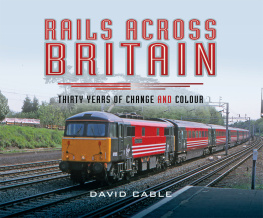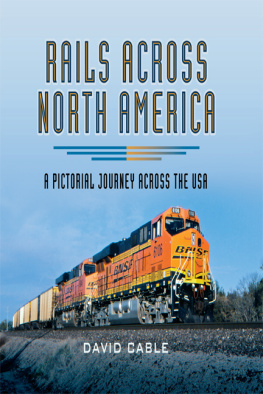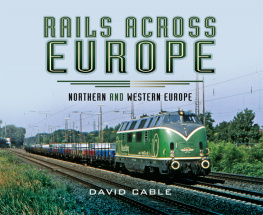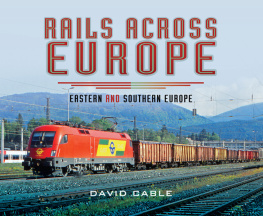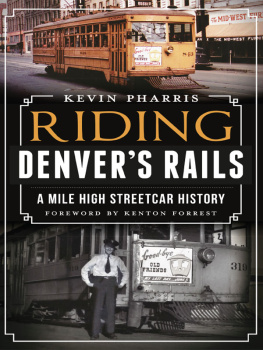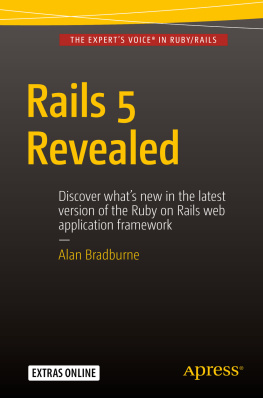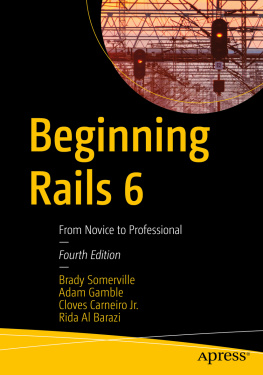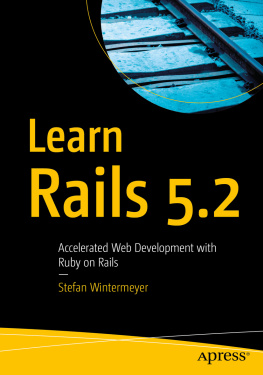Cable David - Rails Across Britain
Here you can read online Cable David - Rails Across Britain full text of the book (entire story) in english for free. Download pdf and epub, get meaning, cover and reviews about this ebook. year: 2017, publisher: Pen & Sword Books, genre: Home and family. Description of the work, (preface) as well as reviews are available. Best literature library LitArk.com created for fans of good reading and offers a wide selection of genres:
Romance novel
Science fiction
Adventure
Detective
Science
History
Home and family
Prose
Art
Politics
Computer
Non-fiction
Religion
Business
Children
Humor
Choose a favorite category and find really read worthwhile books. Enjoy immersion in the world of imagination, feel the emotions of the characters or learn something new for yourself, make an fascinating discovery.
- Book:Rails Across Britain
- Author:
- Publisher:Pen & Sword Books
- Genre:
- Year:2017
- Rating:4 / 5
- Favourites:Add to favourites
- Your mark:
- 80
- 1
- 2
- 3
- 4
- 5
Rails Across Britain: summary, description and annotation
We offer to read an annotation, description, summary or preface (depends on what the author of the book "Rails Across Britain" wrote himself). If you haven't found the necessary information about the book — write in the comments, we will try to find it.
Rails Across Britain — read online for free the complete book (whole text) full work
Below is the text of the book, divided by pages. System saving the place of the last page read, allows you to conveniently read the book "Rails Across Britain" online for free, without having to search again every time where you left off. Put a bookmark, and you can go to the page where you finished reading at any time.
Font size:
Interval:
Bookmark:



First published in Great Britain in 2017 by
Pen & Sword Transport
An imprint of Pen & Sword Books Ltd
47 Church Street
Barnsley
South Yorkshire
S70 2AS
Copyright David Cable 2017
ISBN 9781473849136
The right of David Cable to be identified as the author of this work has been asserted by him in accordance with the Copyright, Designs and Patents Act 1988. All rights reserved. No part of this publication may be reproduced or transmitted in any form or by any means, electronic or mechanical, including photocopy, recording or any information storage and retrieval system, without the prior written permission of the publisher, nor by way of trade or otherwise shall it be lent, re-sold, hired out or otherwise circulated without the publishers prior consent in any form of binding or cover other than that in which it is published and without a similar condition including this condition being imposed on the subsequent purchaser. David Cable 2016
Printed and bound by Replika Press Pvt. Ltd.
Pen & Sword Books Ltd incorporates the imprints of Pen & Sword Archaeology, Atlas, Aviation, Battleground, Discovery, Family History, History, Maritime, Military, Naval, Politics, Railways, Select, Social History, Transport, True Crime, and Claymore Press, Frontline Books, Leo Cooper, Praetorian Press, Remember When, Seaforth Publishing and Wharncliffe.
For a complete list of Pen & Sword titles please contact
Pen & Sword Books Limited
47 Church Street, Barnsley, South Yorkshire, S70 2AS, England
E-mail: enquiries@pen-and-sword.co.uk
Website: www.pen-and-sword.co.uk
DAVID CABLE OTHER PUBLICATIONS
Railfreight in Colour (for the modeller and historian)
BR Passenger Sectors in Colour (for the modeller and historian)
Lost Liveries of Privatisation in Colour (for the modeller and historian)
Hydraulics in the West
The Blue Diesel Era
Rails Across North America A Pictorial Journey Across the USA
Rails Across Canada A Pictorial Journey Across Canada
Rails Across Australia A Journey Through the Continent
Rails Across Europe Northern and Western Europe
Rails Across Europe Eastern and Southern Europe

Rails Across Britain is a photographic album showing virtually all the trains that have operated on the main lines of Great Britain since the mid-1980s to the present day. The book makes reference to Metro train systems, part of which operate on (ex) National Rail tracks (Transport for London, Docklands Light Railway and Tyne & Wear Metro), but excludes tramways, preserved railways and track maintenance equipment, all of which justify books in their own right. Passing reference is made to steam trains operating on the main lines.
The decades that have passed in the thirty year period have, perhaps, seen some of the most dramatic changes to the British Railways system since its inception in the nineteenth century. Not only has the previous state owned British Rail network been sold off to the private sector as far as train operations are concerned (although the funding of track maintenance and development has remained virtually on the governments books), but a substantial change in the types of trains used has taken place.
It was in the mid-1980s that significant structural changes took place within British Rail, under the auspices of Chairman Sir Robert Reid and his successor, Sir Bob Reid. Up until then, BR had worked as a corporate monolith, but it was under these gentlemen that cost centres and control systems were introduced. Although there had been two deviations from the blue and grey corporate identity Scotrail and InterCity these were basically cosmetic. The cost centre regime established separate identities and responsibilities for the different operating elements of BR, namely InterCity, Network South East, Regional Railways, Parcels (later Rail Express Systems) and Railfreight. The latter was further subdivided into Coal, Construction, Metals, Petroleum and Railfreight Distribution (RFD), later becoming Trainload Freight divided into Loadhaul, Mainline, Transrail and Railfreight Distribution, reflecting geographical areas rather than commodities. All of these different sectors carried their own liveries or decals, making a welcome change from the all-pervading BR blue era.
At the outset of this period, there were still many locomotives and multiple units emanating from the 1955 modernisation programme, supplemented by more up-to-date designs from the 1960s and 1970s. But none of these performed to the levels achieved in the twenty-first century. Compared with the present day, there were many more locomotive hauled passenger trains and more frequent freight services whilst industry was still relatively buoyant. It is salutary to reflect on how these numbers have changed over the years. From 1966 to 2015 there has been a 67 per cent reduction in the number of locomotive classes, but only a 25 per cent reduction in multiple units.
In the mid-1990s, the Tory government introduced legislation to privatise the railways, franchised Train Operating Companies (TOCs) working the trains, Rolling Stock Leasing Companies (ROSCOs) providing the rolling stock, and Railtrack/Network Rail maintaining and developing the tracks and infrastructure. The result was a massive change from the financial restrictions imposed by the Treasury on the nationalised BR system, to a surprisingly large level of financial input now funded by the State, and an explosion of colour schemes, some tasteful and others appalling. During the privatisation era, there were many changes in the franchised operators, resulting in new colour schemes (which all have to be paid for by the travelling public) and the demands of the Treasury for the franchisees to pay back premium emoluments.
Whether privatisation has been beneficial is open to conjecture, although the fact remains that passenger numbers have increased dramatically throughout this period. Correspondingly the numbers of freight trains has reduced, especially those handling coal, but instead of many wagon load services in previous years, freight trains are now almost exclusively formed in block loads.
The inconsistent performance of rolling stock, particularly of locomotives, and the dearth of orders for new stock prior to privatisation, resulted in new generations of trains being introduced, although this had been presaged by the acquisition and remarkable performance of EMD built locomotives from 1986 by the stone handling companies in the Mendips Yeoman and ARC and later National Power in Yorkshire. The Trainload Freight and RFD activities had been taken over by Wisconsin Central, whose disgust at the performance of the British Class 47s resulted in them placing an order for 250 up-to-date EMD built locos, the Class 66, which transformed the reliability of the companys locomotive fleet. In turn, Bombardier in particular introduced new and more reliable multiple units, both diesel and electric, in their Turbostar and Electrostar ranges, and these developments have led to more innovative designs over the intervening years, such as the Class 700 Thameslink EMUs and the Class 800 IEP sets.
Font size:
Interval:
Bookmark:
Similar books «Rails Across Britain»
Look at similar books to Rails Across Britain. We have selected literature similar in name and meaning in the hope of providing readers with more options to find new, interesting, not yet read works.
Discussion, reviews of the book Rails Across Britain and just readers' own opinions. Leave your comments, write what you think about the work, its meaning or the main characters. Specify what exactly you liked and what you didn't like, and why you think so.

